Analysis of ASIC v Cassimatis (No. 8) (2016) and Minority Oppression
VerifiedAdded on 2020/03/02
|13
|3441
|66
Case Study
AI Summary
This case study analyzes ASIC v Cassimatis (No. 8) (2016), focusing on the breach of duty of care by directors Emmanuel and Julie Cassimatis of Strom Financial Ltd. The case involves allegations by ASIC regarding the company's financial advice based on the "Storm model" and its contravention of the Corporations Act 2001. The court found the Cassimatises liable, emphasizing the importance of directors' responsibilities, particularly in relation to financial advice and the protection of vulnerable investors. Part B addresses the issue of minority oppression, examining whether Kanye can bring a successful action against other directors/members regarding a share issue or removal as director under the Corporations Act 2001. The analysis covers minority oppression and the remedies available under the Act, highlighting the factors that determine oppressive conduct and the court's powers in such cases. The case underscores the need for directors to balance potential risks and benefits, considering the interests of the corporation as a whole.
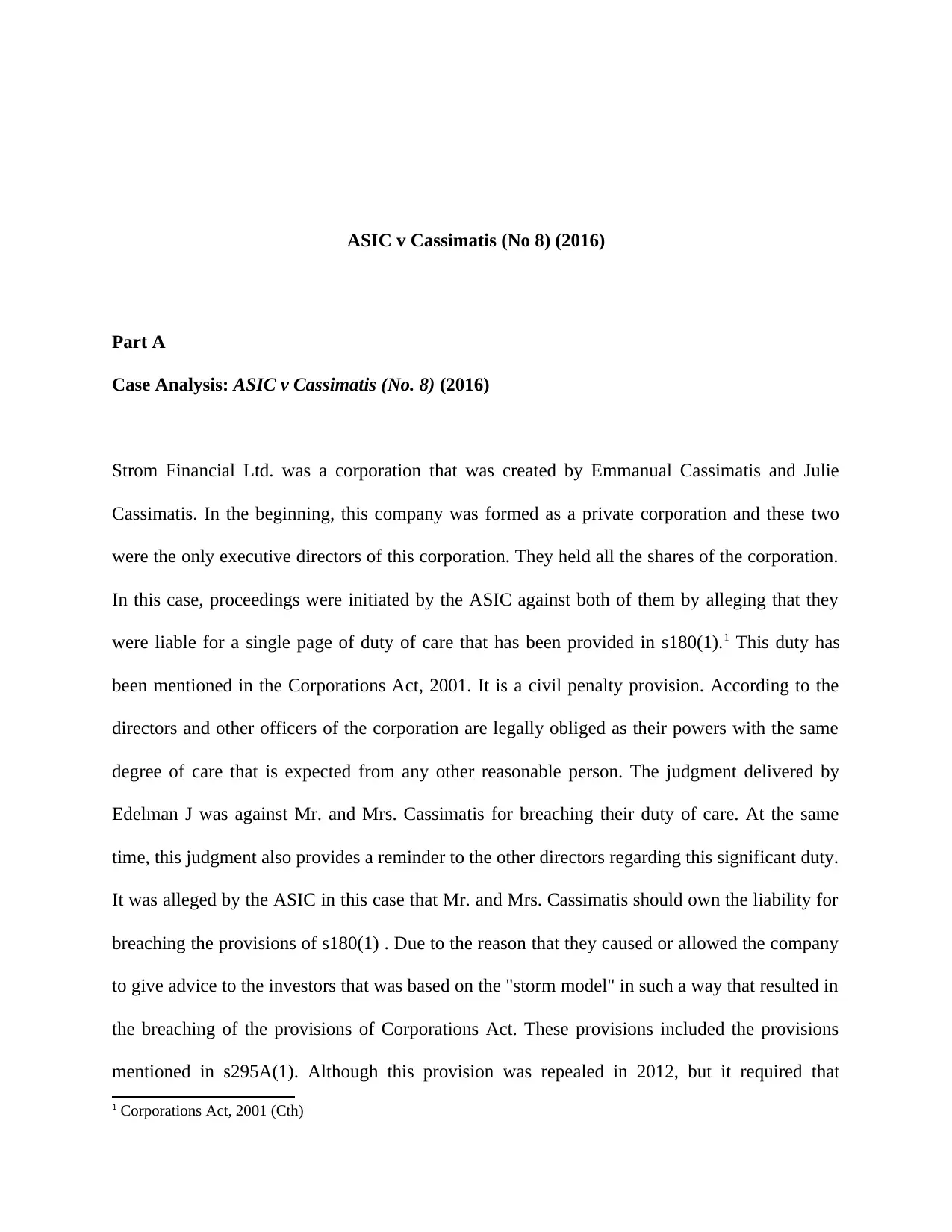
ASIC v Cassimatis (No 8) (2016)
Part A
Case Analysis: ASIC v Cassimatis (No. 8) (2016)
Strom Financial Ltd. was a corporation that was created by Emmanual Cassimatis and Julie
Cassimatis. In the beginning, this company was formed as a private corporation and these two
were the only executive directors of this corporation. They held all the shares of the corporation.
In this case, proceedings were initiated by the ASIC against both of them by alleging that they
were liable for a single page of duty of care that has been provided in s180(1).1 This duty has
been mentioned in the Corporations Act, 2001. It is a civil penalty provision. According to the
directors and other officers of the corporation are legally obliged as their powers with the same
degree of care that is expected from any other reasonable person. The judgment delivered by
Edelman J was against Mr. and Mrs. Cassimatis for breaching their duty of care. At the same
time, this judgment also provides a reminder to the other directors regarding this significant duty.
It was alleged by the ASIC in this case that Mr. and Mrs. Cassimatis should own the liability for
breaching the provisions of s180(1) . Due to the reason that they caused or allowed the company
to give advice to the investors that was based on the "storm model" in such a way that resulted in
the breaching of the provisions of Corporations Act. These provisions included the provisions
mentioned in s295A(1). Although this provision was repealed in 2012, but it required that
1 Corporations Act, 2001 (Cth)
Part A
Case Analysis: ASIC v Cassimatis (No. 8) (2016)
Strom Financial Ltd. was a corporation that was created by Emmanual Cassimatis and Julie
Cassimatis. In the beginning, this company was formed as a private corporation and these two
were the only executive directors of this corporation. They held all the shares of the corporation.
In this case, proceedings were initiated by the ASIC against both of them by alleging that they
were liable for a single page of duty of care that has been provided in s180(1).1 This duty has
been mentioned in the Corporations Act, 2001. It is a civil penalty provision. According to the
directors and other officers of the corporation are legally obliged as their powers with the same
degree of care that is expected from any other reasonable person. The judgment delivered by
Edelman J was against Mr. and Mrs. Cassimatis for breaching their duty of care. At the same
time, this judgment also provides a reminder to the other directors regarding this significant duty.
It was alleged by the ASIC in this case that Mr. and Mrs. Cassimatis should own the liability for
breaching the provisions of s180(1) . Due to the reason that they caused or allowed the company
to give advice to the investors that was based on the "storm model" in such a way that resulted in
the breaching of the provisions of Corporations Act. These provisions included the provisions
mentioned in s295A(1). Although this provision was repealed in 2012, but it required that
1 Corporations Act, 2001 (Cth)
Paraphrase This Document
Need a fresh take? Get an instant paraphrase of this document with our AI Paraphraser
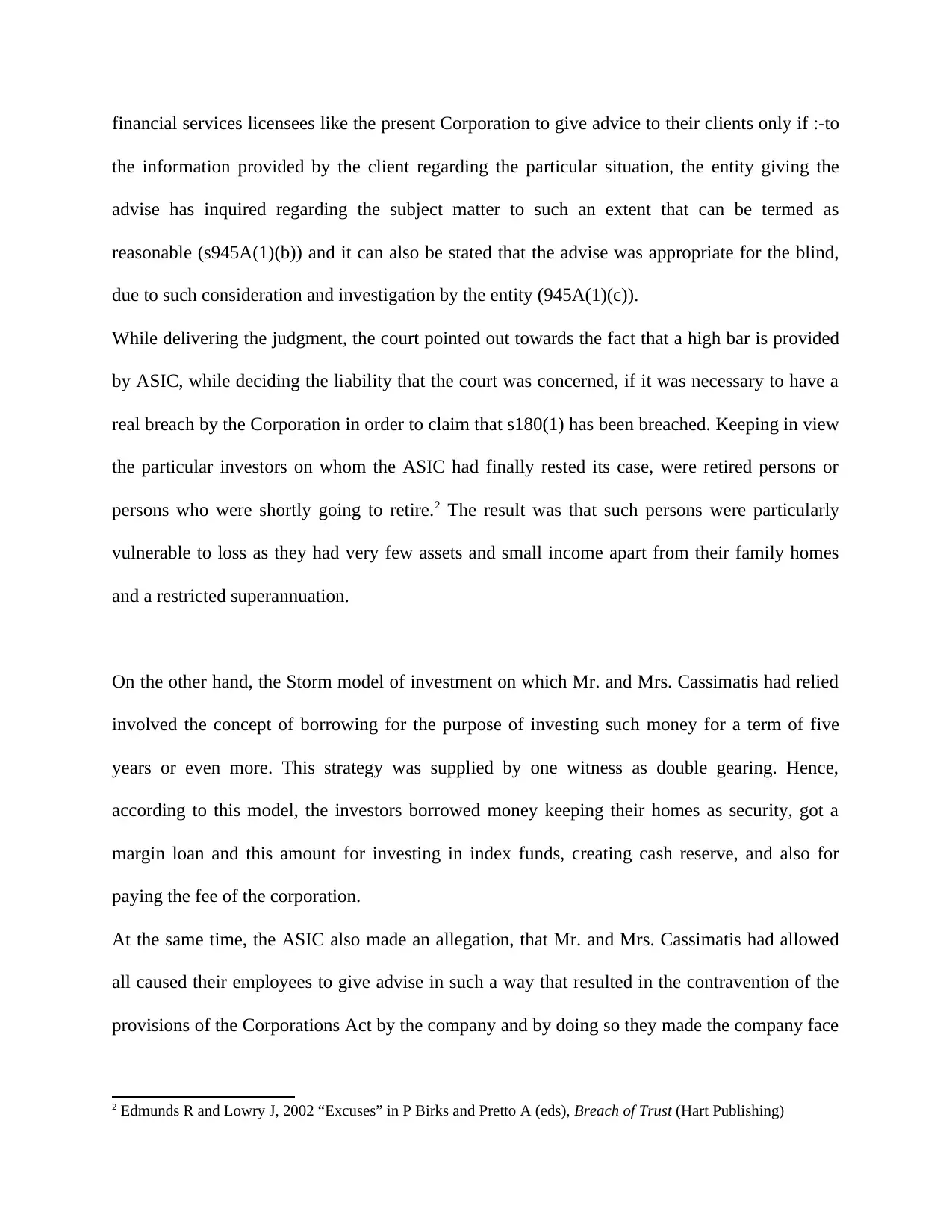
financial services licensees like the present Corporation to give advice to their clients only if :-to
the information provided by the client regarding the particular situation, the entity giving the
advise has inquired regarding the subject matter to such an extent that can be termed as
reasonable (s945A(1)(b)) and it can also be stated that the advise was appropriate for the blind,
due to such consideration and investigation by the entity (945A(1)(c)).
While delivering the judgment, the court pointed out towards the fact that a high bar is provided
by ASIC, while deciding the liability that the court was concerned, if it was necessary to have a
real breach by the Corporation in order to claim that s180(1) has been breached. Keeping in view
the particular investors on whom the ASIC had finally rested its case, were retired persons or
persons who were shortly going to retire.2 The result was that such persons were particularly
vulnerable to loss as they had very few assets and small income apart from their family homes
and a restricted superannuation.
On the other hand, the Storm model of investment on which Mr. and Mrs. Cassimatis had relied
involved the concept of borrowing for the purpose of investing such money for a term of five
years or even more. This strategy was supplied by one witness as double gearing. Hence,
according to this model, the investors borrowed money keeping their homes as security, got a
margin loan and this amount for investing in index funds, creating cash reserve, and also for
paying the fee of the corporation.
At the same time, the ASIC also made an allegation, that Mr. and Mrs. Cassimatis had allowed
all caused their employees to give advise in such a way that resulted in the contravention of the
provisions of the Corporations Act by the company and by doing so they made the company face
2 Edmunds R and Lowry J, 2002 “Excuses” in P Birks and Pretto A (eds), Breach of Trust (Hart Publishing)
the information provided by the client regarding the particular situation, the entity giving the
advise has inquired regarding the subject matter to such an extent that can be termed as
reasonable (s945A(1)(b)) and it can also be stated that the advise was appropriate for the blind,
due to such consideration and investigation by the entity (945A(1)(c)).
While delivering the judgment, the court pointed out towards the fact that a high bar is provided
by ASIC, while deciding the liability that the court was concerned, if it was necessary to have a
real breach by the Corporation in order to claim that s180(1) has been breached. Keeping in view
the particular investors on whom the ASIC had finally rested its case, were retired persons or
persons who were shortly going to retire.2 The result was that such persons were particularly
vulnerable to loss as they had very few assets and small income apart from their family homes
and a restricted superannuation.
On the other hand, the Storm model of investment on which Mr. and Mrs. Cassimatis had relied
involved the concept of borrowing for the purpose of investing such money for a term of five
years or even more. This strategy was supplied by one witness as double gearing. Hence,
according to this model, the investors borrowed money keeping their homes as security, got a
margin loan and this amount for investing in index funds, creating cash reserve, and also for
paying the fee of the corporation.
At the same time, the ASIC also made an allegation, that Mr. and Mrs. Cassimatis had allowed
all caused their employees to give advise in such a way that resulted in the contravention of the
provisions of the Corporations Act by the company and by doing so they made the company face
2 Edmunds R and Lowry J, 2002 “Excuses” in P Birks and Pretto A (eds), Breach of Trust (Hart Publishing)
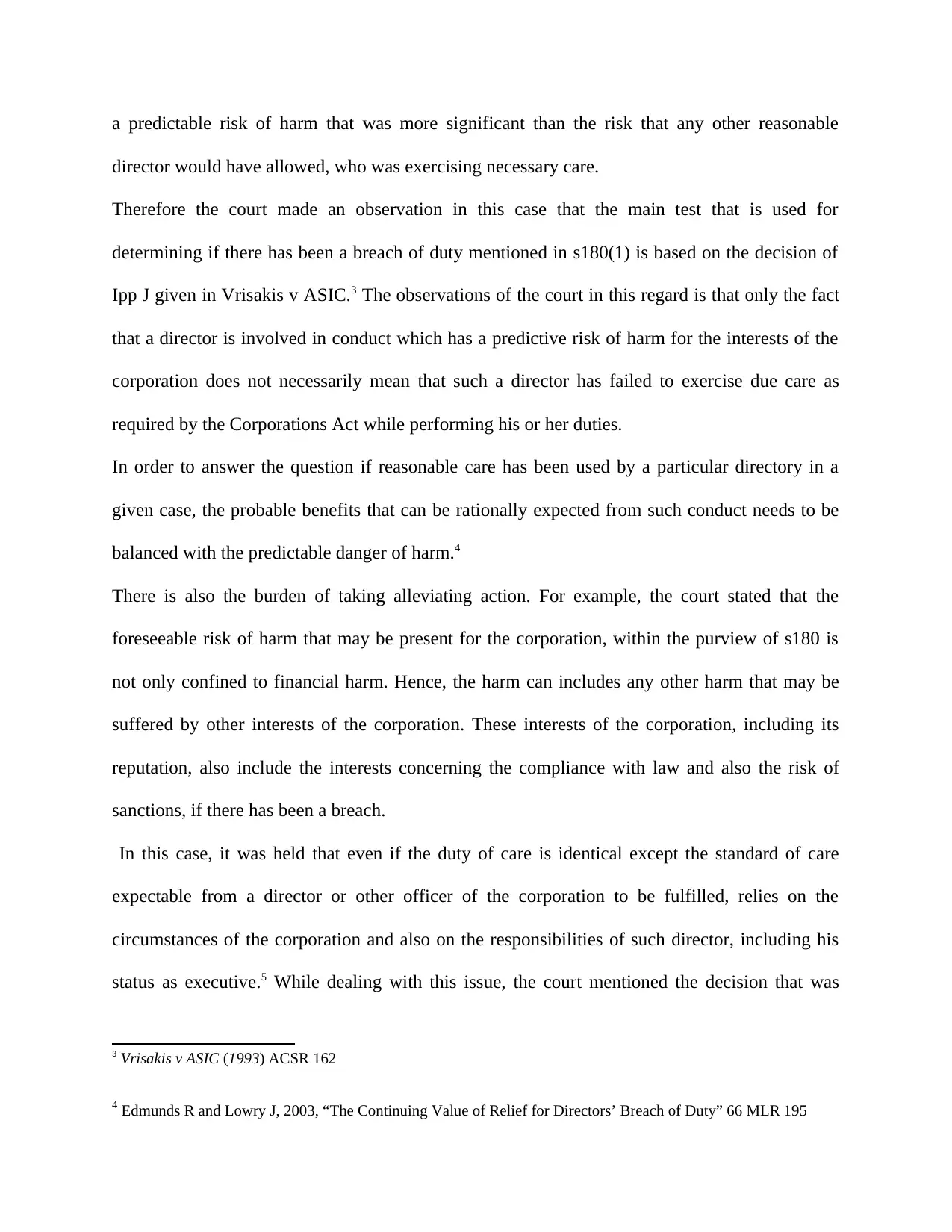
a predictable risk of harm that was more significant than the risk that any other reasonable
director would have allowed, who was exercising necessary care.
Therefore the court made an observation in this case that the main test that is used for
determining if there has been a breach of duty mentioned in s180(1) is based on the decision of
Ipp J given in Vrisakis v ASIC.3 The observations of the court in this regard is that only the fact
that a director is involved in conduct which has a predictive risk of harm for the interests of the
corporation does not necessarily mean that such a director has failed to exercise due care as
required by the Corporations Act while performing his or her duties.
In order to answer the question if reasonable care has been used by a particular directory in a
given case, the probable benefits that can be rationally expected from such conduct needs to be
balanced with the predictable danger of harm.4
There is also the burden of taking alleviating action. For example, the court stated that the
foreseeable risk of harm that may be present for the corporation, within the purview of s180 is
not only confined to financial harm. Hence, the harm can includes any other harm that may be
suffered by other interests of the corporation. These interests of the corporation, including its
reputation, also include the interests concerning the compliance with law and also the risk of
sanctions, if there has been a breach.
In this case, it was held that even if the duty of care is identical except the standard of care
expectable from a director or other officer of the corporation to be fulfilled, relies on the
circumstances of the corporation and also on the responsibilities of such director, including his
status as executive.5 While dealing with this issue, the court mentioned the decision that was
3 Vrisakis v ASIC (1993) ACSR 162
4 Edmunds R and Lowry J, 2003, “The Continuing Value of Relief for Directors’ Breach of Duty” 66 MLR 195
director would have allowed, who was exercising necessary care.
Therefore the court made an observation in this case that the main test that is used for
determining if there has been a breach of duty mentioned in s180(1) is based on the decision of
Ipp J given in Vrisakis v ASIC.3 The observations of the court in this regard is that only the fact
that a director is involved in conduct which has a predictive risk of harm for the interests of the
corporation does not necessarily mean that such a director has failed to exercise due care as
required by the Corporations Act while performing his or her duties.
In order to answer the question if reasonable care has been used by a particular directory in a
given case, the probable benefits that can be rationally expected from such conduct needs to be
balanced with the predictable danger of harm.4
There is also the burden of taking alleviating action. For example, the court stated that the
foreseeable risk of harm that may be present for the corporation, within the purview of s180 is
not only confined to financial harm. Hence, the harm can includes any other harm that may be
suffered by other interests of the corporation. These interests of the corporation, including its
reputation, also include the interests concerning the compliance with law and also the risk of
sanctions, if there has been a breach.
In this case, it was held that even if the duty of care is identical except the standard of care
expectable from a director or other officer of the corporation to be fulfilled, relies on the
circumstances of the corporation and also on the responsibilities of such director, including his
status as executive.5 While dealing with this issue, the court mentioned the decision that was
3 Vrisakis v ASIC (1993) ACSR 162
4 Edmunds R and Lowry J, 2003, “The Continuing Value of Relief for Directors’ Breach of Duty” 66 MLR 195
⊘ This is a preview!⊘
Do you want full access?
Subscribe today to unlock all pages.

Trusted by 1+ million students worldwide
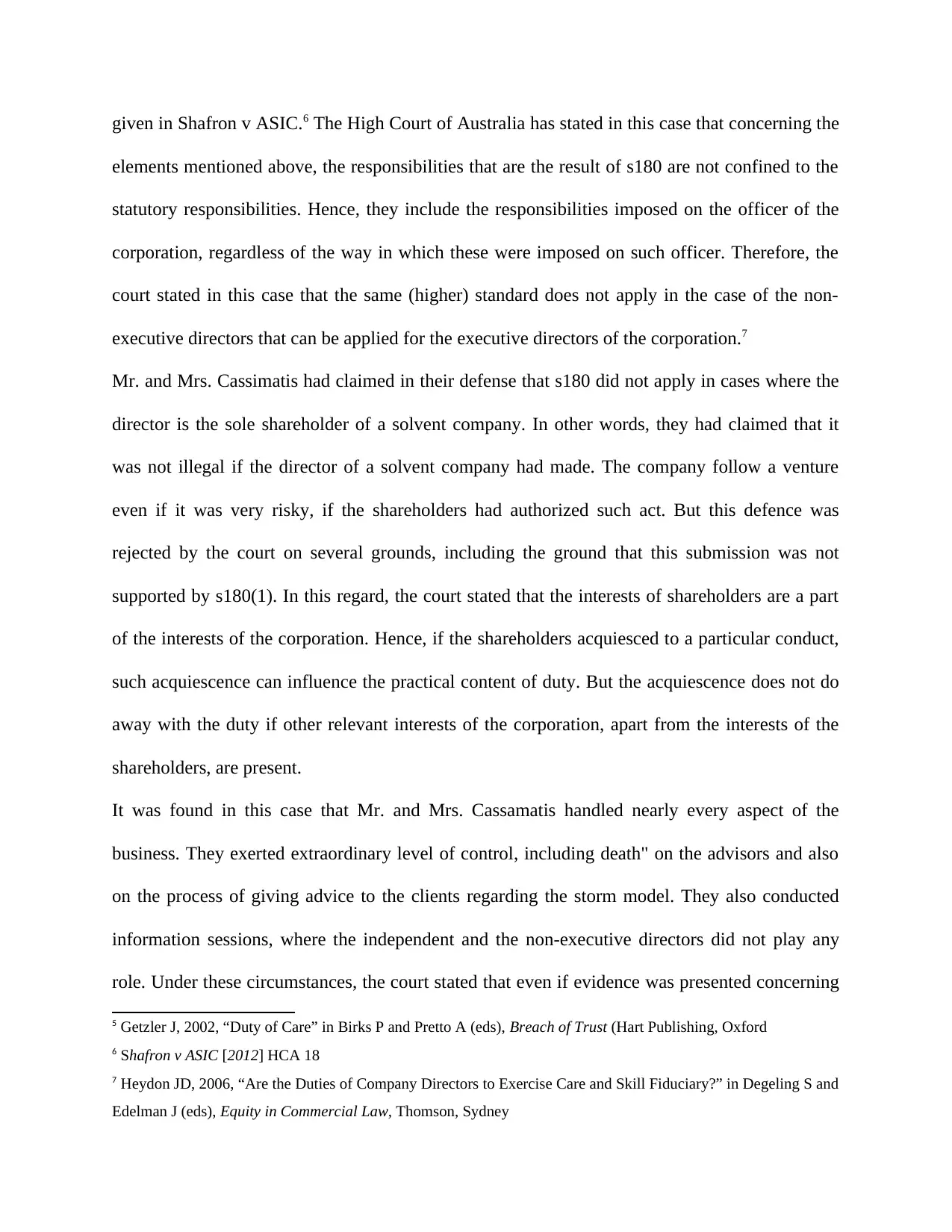
given in Shafron v ASIC.6 The High Court of Australia has stated in this case that concerning the
elements mentioned above, the responsibilities that are the result of s180 are not confined to the
statutory responsibilities. Hence, they include the responsibilities imposed on the officer of the
corporation, regardless of the way in which these were imposed on such officer. Therefore, the
court stated in this case that the same (higher) standard does not apply in the case of the non-
executive directors that can be applied for the executive directors of the corporation.7
Mr. and Mrs. Cassimatis had claimed in their defense that s180 did not apply in cases where the
director is the sole shareholder of a solvent company. In other words, they had claimed that it
was not illegal if the director of a solvent company had made. The company follow a venture
even if it was very risky, if the shareholders had authorized such act. But this defence was
rejected by the court on several grounds, including the ground that this submission was not
supported by s180(1). In this regard, the court stated that the interests of shareholders are a part
of the interests of the corporation. Hence, if the shareholders acquiesced to a particular conduct,
such acquiescence can influence the practical content of duty. But the acquiescence does not do
away with the duty if other relevant interests of the corporation, apart from the interests of the
shareholders, are present.
It was found in this case that Mr. and Mrs. Cassamatis handled nearly every aspect of the
business. They exerted extraordinary level of control, including death" on the advisors and also
on the process of giving advice to the clients regarding the storm model. They also conducted
information sessions, where the independent and the non-executive directors did not play any
role. Under these circumstances, the court stated that even if evidence was presented concerning
5 Getzler J, 2002, “Duty of Care” in Birks P and Pretto A (eds), Breach of Trust (Hart Publishing, Oxford
6 Shafron v ASIC [2012] HCA 18
7 Heydon JD, 2006, “Are the Duties of Company Directors to Exercise Care and Skill Fiduciary?” in Degeling S and
Edelman J (eds), Equity in Commercial Law, Thomson, Sydney
elements mentioned above, the responsibilities that are the result of s180 are not confined to the
statutory responsibilities. Hence, they include the responsibilities imposed on the officer of the
corporation, regardless of the way in which these were imposed on such officer. Therefore, the
court stated in this case that the same (higher) standard does not apply in the case of the non-
executive directors that can be applied for the executive directors of the corporation.7
Mr. and Mrs. Cassimatis had claimed in their defense that s180 did not apply in cases where the
director is the sole shareholder of a solvent company. In other words, they had claimed that it
was not illegal if the director of a solvent company had made. The company follow a venture
even if it was very risky, if the shareholders had authorized such act. But this defence was
rejected by the court on several grounds, including the ground that this submission was not
supported by s180(1). In this regard, the court stated that the interests of shareholders are a part
of the interests of the corporation. Hence, if the shareholders acquiesced to a particular conduct,
such acquiescence can influence the practical content of duty. But the acquiescence does not do
away with the duty if other relevant interests of the corporation, apart from the interests of the
shareholders, are present.
It was found in this case that Mr. and Mrs. Cassamatis handled nearly every aspect of the
business. They exerted extraordinary level of control, including death" on the advisors and also
on the process of giving advice to the clients regarding the storm model. They also conducted
information sessions, where the independent and the non-executive directors did not play any
role. Under these circumstances, the court stated that even if evidence was presented concerning
5 Getzler J, 2002, “Duty of Care” in Birks P and Pretto A (eds), Breach of Trust (Hart Publishing, Oxford
6 Shafron v ASIC [2012] HCA 18
7 Heydon JD, 2006, “Are the Duties of Company Directors to Exercise Care and Skill Fiduciary?” in Degeling S and
Edelman J (eds), Equity in Commercial Law, Thomson, Sydney
Paraphrase This Document
Need a fresh take? Get an instant paraphrase of this document with our AI Paraphraser
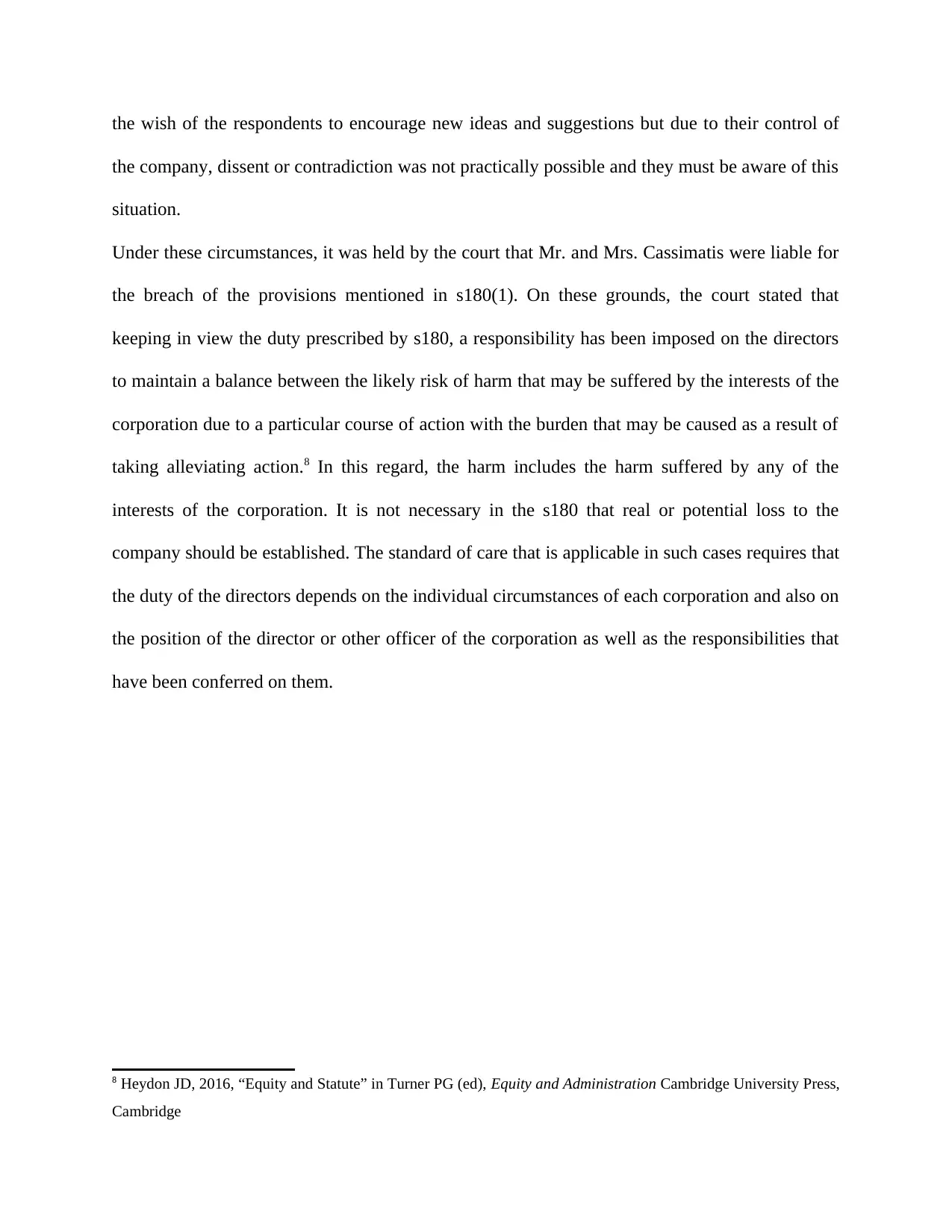
the wish of the respondents to encourage new ideas and suggestions but due to their control of
the company, dissent or contradiction was not practically possible and they must be aware of this
situation.
Under these circumstances, it was held by the court that Mr. and Mrs. Cassimatis were liable for
the breach of the provisions mentioned in s180(1). On these grounds, the court stated that
keeping in view the duty prescribed by s180, a responsibility has been imposed on the directors
to maintain a balance between the likely risk of harm that may be suffered by the interests of the
corporation due to a particular course of action with the burden that may be caused as a result of
taking alleviating action.8 In this regard, the harm includes the harm suffered by any of the
interests of the corporation. It is not necessary in the s180 that real or potential loss to the
company should be established. The standard of care that is applicable in such cases requires that
the duty of the directors depends on the individual circumstances of each corporation and also on
the position of the director or other officer of the corporation as well as the responsibilities that
have been conferred on them.
8 Heydon JD, 2016, “Equity and Statute” in Turner PG (ed), Equity and Administration Cambridge University Press,
Cambridge
the company, dissent or contradiction was not practically possible and they must be aware of this
situation.
Under these circumstances, it was held by the court that Mr. and Mrs. Cassimatis were liable for
the breach of the provisions mentioned in s180(1). On these grounds, the court stated that
keeping in view the duty prescribed by s180, a responsibility has been imposed on the directors
to maintain a balance between the likely risk of harm that may be suffered by the interests of the
corporation due to a particular course of action with the burden that may be caused as a result of
taking alleviating action.8 In this regard, the harm includes the harm suffered by any of the
interests of the corporation. It is not necessary in the s180 that real or potential loss to the
company should be established. The standard of care that is applicable in such cases requires that
the duty of the directors depends on the individual circumstances of each corporation and also on
the position of the director or other officer of the corporation as well as the responsibilities that
have been conferred on them.
8 Heydon JD, 2016, “Equity and Statute” in Turner PG (ed), Equity and Administration Cambridge University Press,
Cambridge
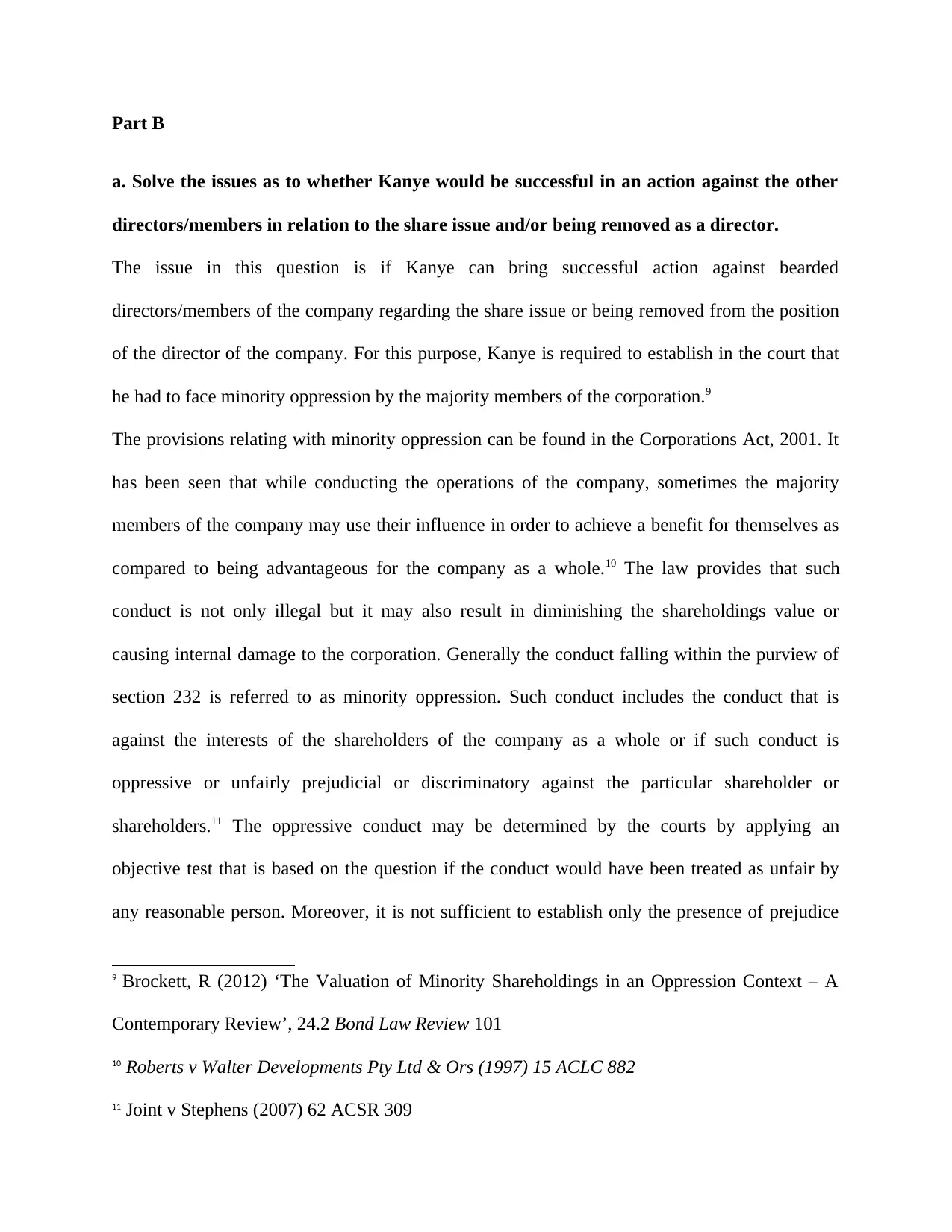
Part B
a. Solve the issues as to whether Kanye would be successful in an action against the other
directors/members in relation to the share issue and/or being removed as a director.
The issue in this question is if Kanye can bring successful action against bearded
directors/members of the company regarding the share issue or being removed from the position
of the director of the company. For this purpose, Kanye is required to establish in the court that
he had to face minority oppression by the majority members of the corporation.9
The provisions relating with minority oppression can be found in the Corporations Act, 2001. It
has been seen that while conducting the operations of the company, sometimes the majority
members of the company may use their influence in order to achieve a benefit for themselves as
compared to being advantageous for the company as a whole.10 The law provides that such
conduct is not only illegal but it may also result in diminishing the shareholdings value or
causing internal damage to the corporation. Generally the conduct falling within the purview of
section 232 is referred to as minority oppression. Such conduct includes the conduct that is
against the interests of the shareholders of the company as a whole or if such conduct is
oppressive or unfairly prejudicial or discriminatory against the particular shareholder or
shareholders.11 The oppressive conduct may be determined by the courts by applying an
objective test that is based on the question if the conduct would have been treated as unfair by
any reasonable person. Moreover, it is not sufficient to establish only the presence of prejudice
9 Brockett, R (2012) ‘The Valuation of Minority Shareholdings in an Oppression Context – A
Contemporary Review’, 24.2 Bond Law Review 101
10 Roberts v Walter Developments Pty Ltd & Ors (1997) 15 ACLC 882
11 Joint v Stephens (2007) 62 ACSR 309
a. Solve the issues as to whether Kanye would be successful in an action against the other
directors/members in relation to the share issue and/or being removed as a director.
The issue in this question is if Kanye can bring successful action against bearded
directors/members of the company regarding the share issue or being removed from the position
of the director of the company. For this purpose, Kanye is required to establish in the court that
he had to face minority oppression by the majority members of the corporation.9
The provisions relating with minority oppression can be found in the Corporations Act, 2001. It
has been seen that while conducting the operations of the company, sometimes the majority
members of the company may use their influence in order to achieve a benefit for themselves as
compared to being advantageous for the company as a whole.10 The law provides that such
conduct is not only illegal but it may also result in diminishing the shareholdings value or
causing internal damage to the corporation. Generally the conduct falling within the purview of
section 232 is referred to as minority oppression. Such conduct includes the conduct that is
against the interests of the shareholders of the company as a whole or if such conduct is
oppressive or unfairly prejudicial or discriminatory against the particular shareholder or
shareholders.11 The oppressive conduct may be determined by the courts by applying an
objective test that is based on the question if the conduct would have been treated as unfair by
any reasonable person. Moreover, it is not sufficient to establish only the presence of prejudice
9 Brockett, R (2012) ‘The Valuation of Minority Shareholdings in an Oppression Context – A
Contemporary Review’, 24.2 Bond Law Review 101
10 Roberts v Walter Developments Pty Ltd & Ors (1997) 15 ACLC 882
11 Joint v Stephens (2007) 62 ACSR 309
⊘ This is a preview!⊘
Do you want full access?
Subscribe today to unlock all pages.

Trusted by 1+ million students worldwide
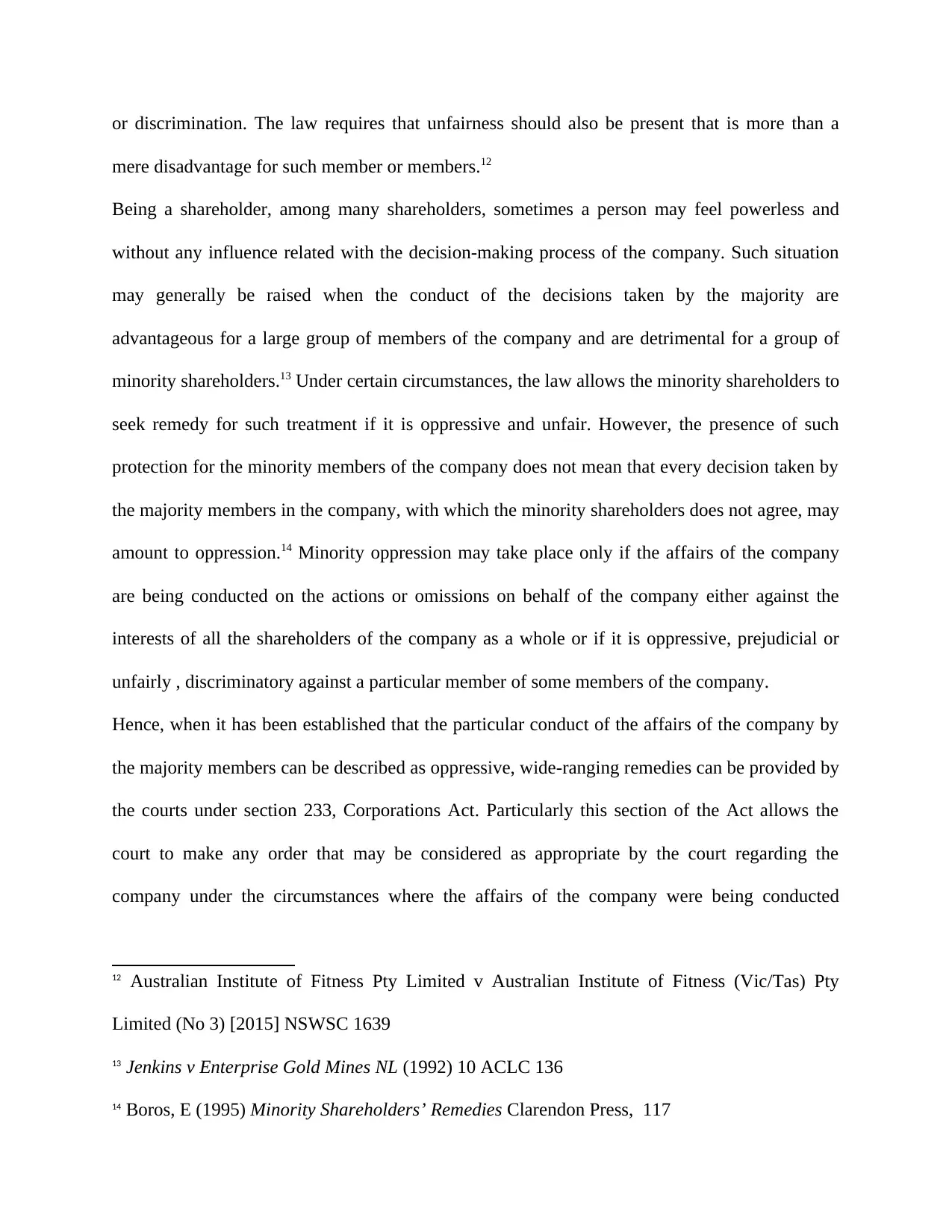
or discrimination. The law requires that unfairness should also be present that is more than a
mere disadvantage for such member or members.12
Being a shareholder, among many shareholders, sometimes a person may feel powerless and
without any influence related with the decision-making process of the company. Such situation
may generally be raised when the conduct of the decisions taken by the majority are
advantageous for a large group of members of the company and are detrimental for a group of
minority shareholders.13 Under certain circumstances, the law allows the minority shareholders to
seek remedy for such treatment if it is oppressive and unfair. However, the presence of such
protection for the minority members of the company does not mean that every decision taken by
the majority members in the company, with which the minority shareholders does not agree, may
amount to oppression.14 Minority oppression may take place only if the affairs of the company
are being conducted on the actions or omissions on behalf of the company either against the
interests of all the shareholders of the company as a whole or if it is oppressive, prejudicial or
unfairly , discriminatory against a particular member of some members of the company.
Hence, when it has been established that the particular conduct of the affairs of the company by
the majority members can be described as oppressive, wide-ranging remedies can be provided by
the courts under section 233, Corporations Act. Particularly this section of the Act allows the
court to make any order that may be considered as appropriate by the court regarding the
company under the circumstances where the affairs of the company were being conducted
12 Australian Institute of Fitness Pty Limited v Australian Institute of Fitness (Vic/Tas) Pty
Limited (No 3) [2015] NSWSC 1639
13 Jenkins v Enterprise Gold Mines NL (1992) 10 ACLC 136
14 Boros, E (1995) Minority Shareholders’ Remedies Clarendon Press, 117
mere disadvantage for such member or members.12
Being a shareholder, among many shareholders, sometimes a person may feel powerless and
without any influence related with the decision-making process of the company. Such situation
may generally be raised when the conduct of the decisions taken by the majority are
advantageous for a large group of members of the company and are detrimental for a group of
minority shareholders.13 Under certain circumstances, the law allows the minority shareholders to
seek remedy for such treatment if it is oppressive and unfair. However, the presence of such
protection for the minority members of the company does not mean that every decision taken by
the majority members in the company, with which the minority shareholders does not agree, may
amount to oppression.14 Minority oppression may take place only if the affairs of the company
are being conducted on the actions or omissions on behalf of the company either against the
interests of all the shareholders of the company as a whole or if it is oppressive, prejudicial or
unfairly , discriminatory against a particular member of some members of the company.
Hence, when it has been established that the particular conduct of the affairs of the company by
the majority members can be described as oppressive, wide-ranging remedies can be provided by
the courts under section 233, Corporations Act. Particularly this section of the Act allows the
court to make any order that may be considered as appropriate by the court regarding the
company under the circumstances where the affairs of the company were being conducted
12 Australian Institute of Fitness Pty Limited v Australian Institute of Fitness (Vic/Tas) Pty
Limited (No 3) [2015] NSWSC 1639
13 Jenkins v Enterprise Gold Mines NL (1992) 10 ACLC 136
14 Boros, E (1995) Minority Shareholders’ Remedies Clarendon Press, 117
Paraphrase This Document
Need a fresh take? Get an instant paraphrase of this document with our AI Paraphraser
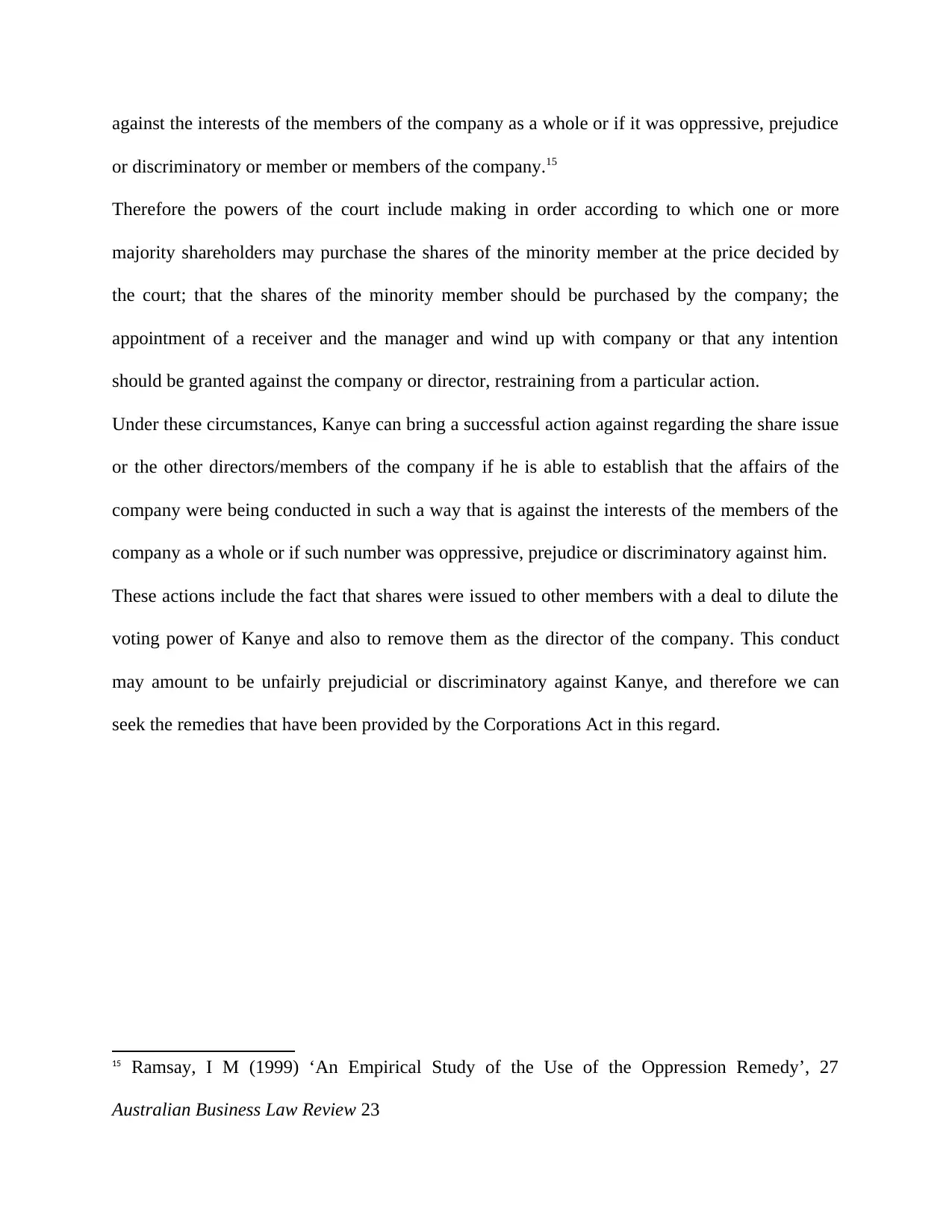
against the interests of the members of the company as a whole or if it was oppressive, prejudice
or discriminatory or member or members of the company.15
Therefore the powers of the court include making in order according to which one or more
majority shareholders may purchase the shares of the minority member at the price decided by
the court; that the shares of the minority member should be purchased by the company; the
appointment of a receiver and the manager and wind up with company or that any intention
should be granted against the company or director, restraining from a particular action.
Under these circumstances, Kanye can bring a successful action against regarding the share issue
or the other directors/members of the company if he is able to establish that the affairs of the
company were being conducted in such a way that is against the interests of the members of the
company as a whole or if such number was oppressive, prejudice or discriminatory against him.
These actions include the fact that shares were issued to other members with a deal to dilute the
voting power of Kanye and also to remove them as the director of the company. This conduct
may amount to be unfairly prejudicial or discriminatory against Kanye, and therefore we can
seek the remedies that have been provided by the Corporations Act in this regard.
15 Ramsay, I M (1999) ‘An Empirical Study of the Use of the Oppression Remedy’, 27
Australian Business Law Review 23
or discriminatory or member or members of the company.15
Therefore the powers of the court include making in order according to which one or more
majority shareholders may purchase the shares of the minority member at the price decided by
the court; that the shares of the minority member should be purchased by the company; the
appointment of a receiver and the manager and wind up with company or that any intention
should be granted against the company or director, restraining from a particular action.
Under these circumstances, Kanye can bring a successful action against regarding the share issue
or the other directors/members of the company if he is able to establish that the affairs of the
company were being conducted in such a way that is against the interests of the members of the
company as a whole or if such number was oppressive, prejudice or discriminatory against him.
These actions include the fact that shares were issued to other members with a deal to dilute the
voting power of Kanye and also to remove them as the director of the company. This conduct
may amount to be unfairly prejudicial or discriminatory against Kanye, and therefore we can
seek the remedies that have been provided by the Corporations Act in this regard.
15 Ramsay, I M (1999) ‘An Empirical Study of the Use of the Oppression Remedy’, 27
Australian Business Law Review 23
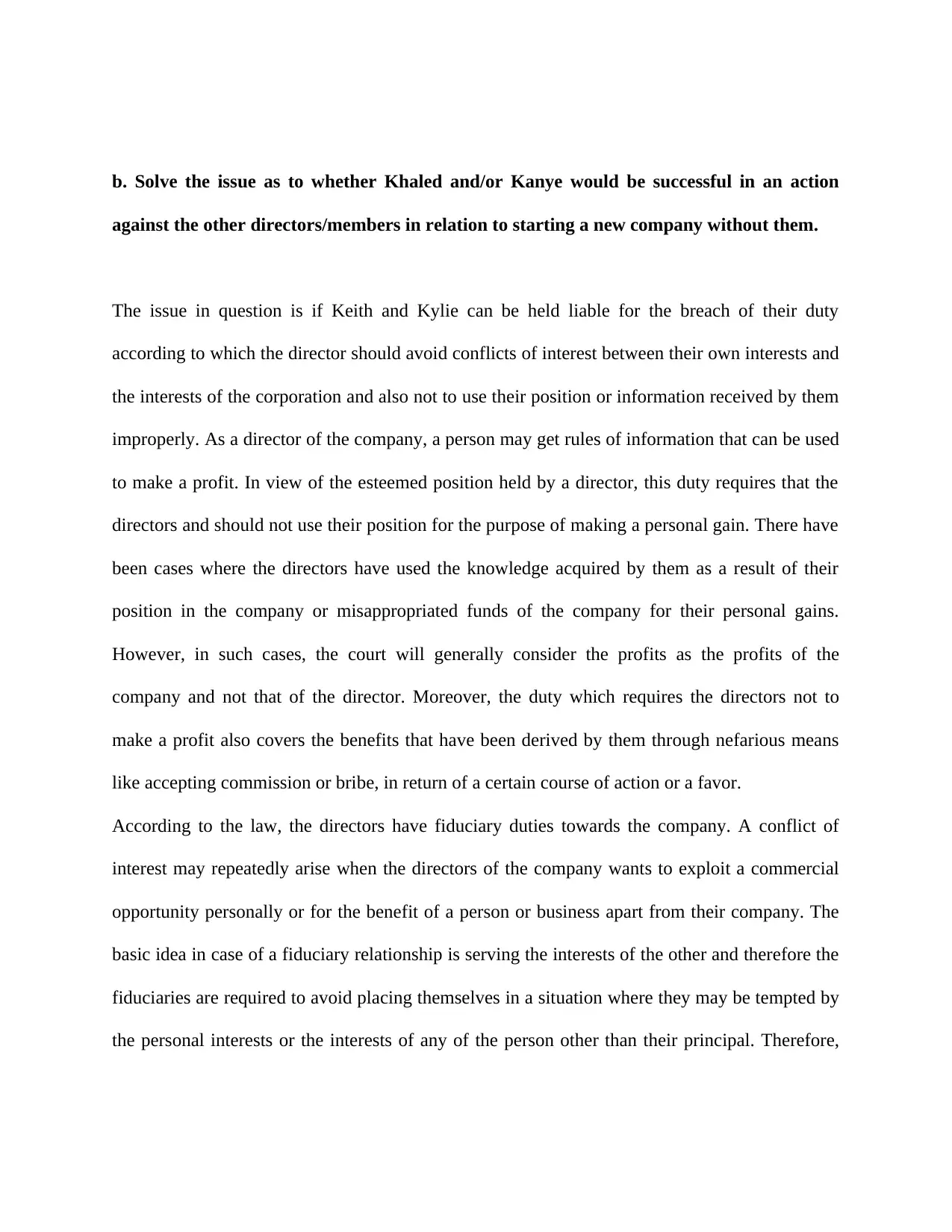
b. Solve the issue as to whether Khaled and/or Kanye would be successful in an action
against the other directors/members in relation to starting a new company without them.
The issue in question is if Keith and Kylie can be held liable for the breach of their duty
according to which the director should avoid conflicts of interest between their own interests and
the interests of the corporation and also not to use their position or information received by them
improperly. As a director of the company, a person may get rules of information that can be used
to make a profit. In view of the esteemed position held by a director, this duty requires that the
directors and should not use their position for the purpose of making a personal gain. There have
been cases where the directors have used the knowledge acquired by them as a result of their
position in the company or misappropriated funds of the company for their personal gains.
However, in such cases, the court will generally consider the profits as the profits of the
company and not that of the director. Moreover, the duty which requires the directors not to
make a profit also covers the benefits that have been derived by them through nefarious means
like accepting commission or bribe, in return of a certain course of action or a favor.
According to the law, the directors have fiduciary duties towards the company. A conflict of
interest may repeatedly arise when the directors of the company wants to exploit a commercial
opportunity personally or for the benefit of a person or business apart from their company. The
basic idea in case of a fiduciary relationship is serving the interests of the other and therefore the
fiduciaries are required to avoid placing themselves in a situation where they may be tempted by
the personal interests or the interests of any of the person other than their principal. Therefore,
against the other directors/members in relation to starting a new company without them.
The issue in question is if Keith and Kylie can be held liable for the breach of their duty
according to which the director should avoid conflicts of interest between their own interests and
the interests of the corporation and also not to use their position or information received by them
improperly. As a director of the company, a person may get rules of information that can be used
to make a profit. In view of the esteemed position held by a director, this duty requires that the
directors and should not use their position for the purpose of making a personal gain. There have
been cases where the directors have used the knowledge acquired by them as a result of their
position in the company or misappropriated funds of the company for their personal gains.
However, in such cases, the court will generally consider the profits as the profits of the
company and not that of the director. Moreover, the duty which requires the directors not to
make a profit also covers the benefits that have been derived by them through nefarious means
like accepting commission or bribe, in return of a certain course of action or a favor.
According to the law, the directors have fiduciary duties towards the company. A conflict of
interest may repeatedly arise when the directors of the company wants to exploit a commercial
opportunity personally or for the benefit of a person or business apart from their company. The
basic idea in case of a fiduciary relationship is serving the interests of the other and therefore the
fiduciaries are required to avoid placing themselves in a situation where they may be tempted by
the personal interests or the interests of any of the person other than their principal. Therefore,
⊘ This is a preview!⊘
Do you want full access?
Subscribe today to unlock all pages.

Trusted by 1+ million students worldwide
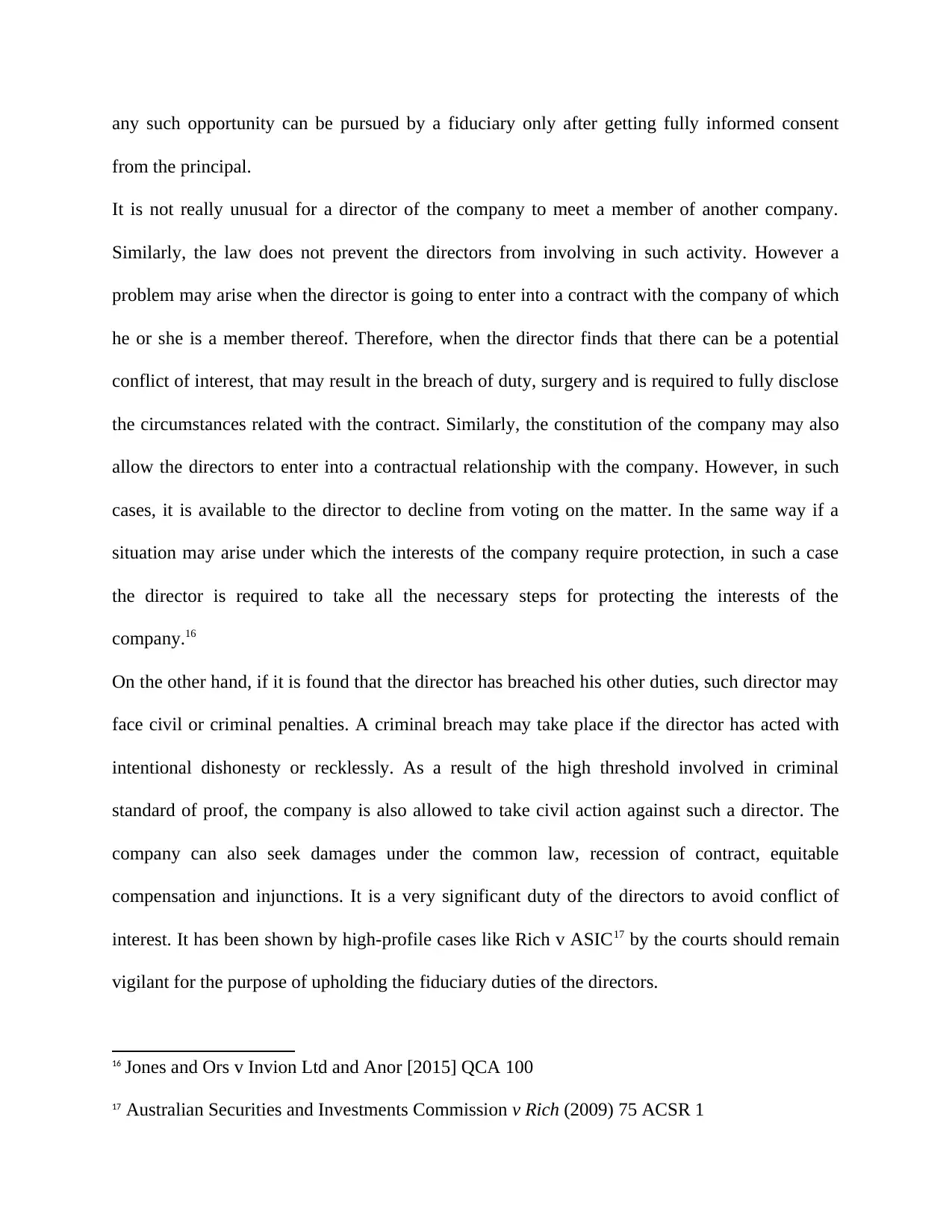
any such opportunity can be pursued by a fiduciary only after getting fully informed consent
from the principal.
It is not really unusual for a director of the company to meet a member of another company.
Similarly, the law does not prevent the directors from involving in such activity. However a
problem may arise when the director is going to enter into a contract with the company of which
he or she is a member thereof. Therefore, when the director finds that there can be a potential
conflict of interest, that may result in the breach of duty, surgery and is required to fully disclose
the circumstances related with the contract. Similarly, the constitution of the company may also
allow the directors to enter into a contractual relationship with the company. However, in such
cases, it is available to the director to decline from voting on the matter. In the same way if a
situation may arise under which the interests of the company require protection, in such a case
the director is required to take all the necessary steps for protecting the interests of the
company.16
On the other hand, if it is found that the director has breached his other duties, such director may
face civil or criminal penalties. A criminal breach may take place if the director has acted with
intentional dishonesty or recklessly. As a result of the high threshold involved in criminal
standard of proof, the company is also allowed to take civil action against such a director. The
company can also seek damages under the common law, recession of contract, equitable
compensation and injunctions. It is a very significant duty of the directors to avoid conflict of
interest. It has been shown by high-profile cases like Rich v ASIC17 by the courts should remain
vigilant for the purpose of upholding the fiduciary duties of the directors.
16 Jones and Ors v Invion Ltd and Anor [2015] QCA 100
17 Australian Securities and Investments Commission v Rich (2009) 75 ACSR 1
from the principal.
It is not really unusual for a director of the company to meet a member of another company.
Similarly, the law does not prevent the directors from involving in such activity. However a
problem may arise when the director is going to enter into a contract with the company of which
he or she is a member thereof. Therefore, when the director finds that there can be a potential
conflict of interest, that may result in the breach of duty, surgery and is required to fully disclose
the circumstances related with the contract. Similarly, the constitution of the company may also
allow the directors to enter into a contractual relationship with the company. However, in such
cases, it is available to the director to decline from voting on the matter. In the same way if a
situation may arise under which the interests of the company require protection, in such a case
the director is required to take all the necessary steps for protecting the interests of the
company.16
On the other hand, if it is found that the director has breached his other duties, such director may
face civil or criminal penalties. A criminal breach may take place if the director has acted with
intentional dishonesty or recklessly. As a result of the high threshold involved in criminal
standard of proof, the company is also allowed to take civil action against such a director. The
company can also seek damages under the common law, recession of contract, equitable
compensation and injunctions. It is a very significant duty of the directors to avoid conflict of
interest. It has been shown by high-profile cases like Rich v ASIC17 by the courts should remain
vigilant for the purpose of upholding the fiduciary duties of the directors.
16 Jones and Ors v Invion Ltd and Anor [2015] QCA 100
17 Australian Securities and Investments Commission v Rich (2009) 75 ACSR 1
Paraphrase This Document
Need a fresh take? Get an instant paraphrase of this document with our AI Paraphraser

Hence in the present case also, Khaled and Kanye can successfully bring action against the other
directors/members of Koala Pty Ltd. if they can establish a breach of duties by these directors.
directors/members of Koala Pty Ltd. if they can establish a breach of duties by these directors.
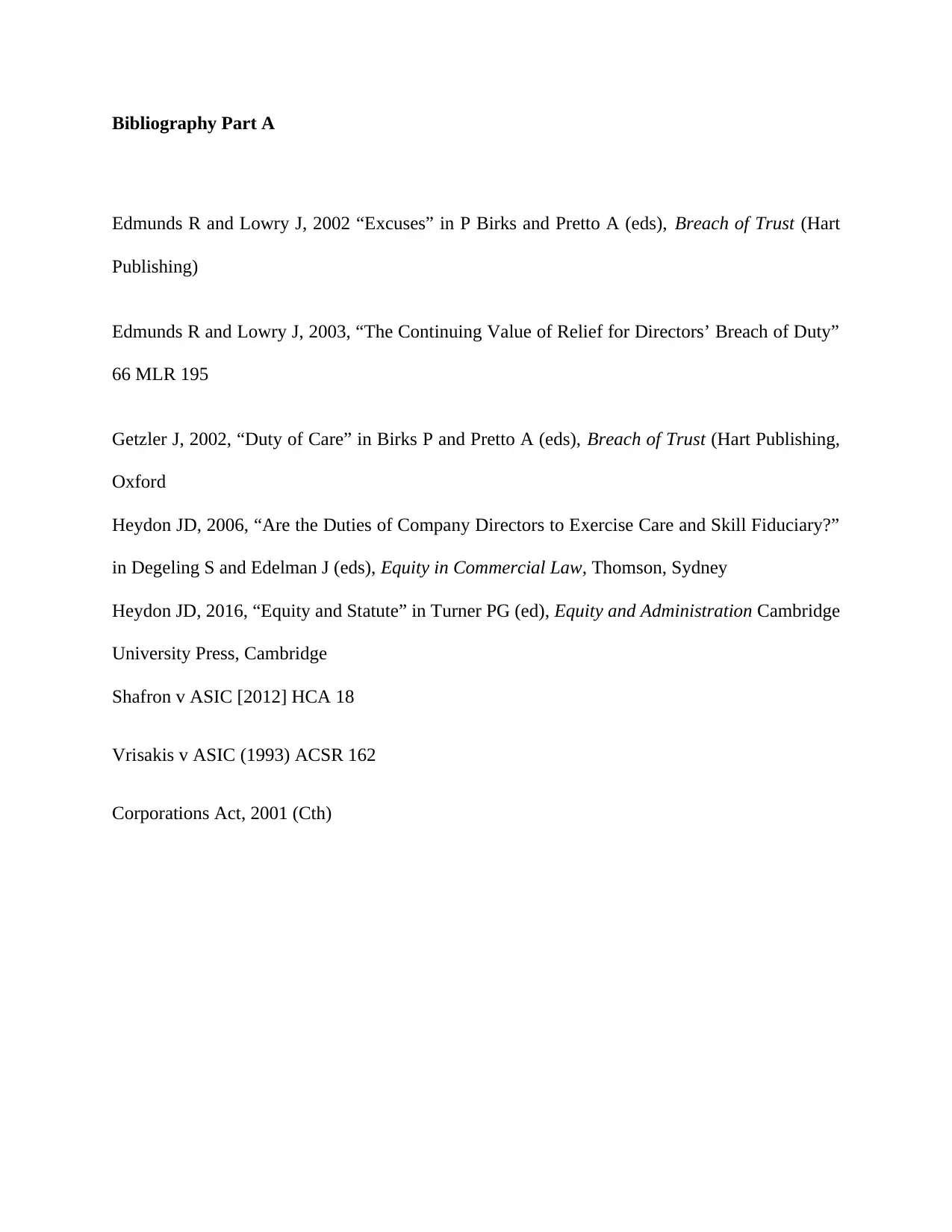
Bibliography Part A
Edmunds R and Lowry J, 2002 “Excuses” in P Birks and Pretto A (eds), Breach of Trust (Hart
Publishing)
Edmunds R and Lowry J, 2003, “The Continuing Value of Relief for Directors’ Breach of Duty”
66 MLR 195
Getzler J, 2002, “Duty of Care” in Birks P and Pretto A (eds), Breach of Trust (Hart Publishing,
Oxford
Heydon JD, 2006, “Are the Duties of Company Directors to Exercise Care and Skill Fiduciary?”
in Degeling S and Edelman J (eds), Equity in Commercial Law, Thomson, Sydney
Heydon JD, 2016, “Equity and Statute” in Turner PG (ed), Equity and Administration Cambridge
University Press, Cambridge
Shafron v ASIC [2012] HCA 18
Vrisakis v ASIC (1993) ACSR 162
Corporations Act, 2001 (Cth)
Edmunds R and Lowry J, 2002 “Excuses” in P Birks and Pretto A (eds), Breach of Trust (Hart
Publishing)
Edmunds R and Lowry J, 2003, “The Continuing Value of Relief for Directors’ Breach of Duty”
66 MLR 195
Getzler J, 2002, “Duty of Care” in Birks P and Pretto A (eds), Breach of Trust (Hart Publishing,
Oxford
Heydon JD, 2006, “Are the Duties of Company Directors to Exercise Care and Skill Fiduciary?”
in Degeling S and Edelman J (eds), Equity in Commercial Law, Thomson, Sydney
Heydon JD, 2016, “Equity and Statute” in Turner PG (ed), Equity and Administration Cambridge
University Press, Cambridge
Shafron v ASIC [2012] HCA 18
Vrisakis v ASIC (1993) ACSR 162
Corporations Act, 2001 (Cth)
⊘ This is a preview!⊘
Do you want full access?
Subscribe today to unlock all pages.

Trusted by 1+ million students worldwide
1 out of 13
Related Documents
Your All-in-One AI-Powered Toolkit for Academic Success.
+13062052269
info@desklib.com
Available 24*7 on WhatsApp / Email
![[object Object]](/_next/static/media/star-bottom.7253800d.svg)
Unlock your academic potential
Copyright © 2020–2025 A2Z Services. All Rights Reserved. Developed and managed by ZUCOL.





![HA3021 Corporations Law: Case Study on ASIC v Cassimatis [2016]](/_next/image/?url=https%3A%2F%2Fdesklib.com%2Fmedia%2Fasic-cassimatis-breach-director-duty_page_2.jpg&w=256&q=75)